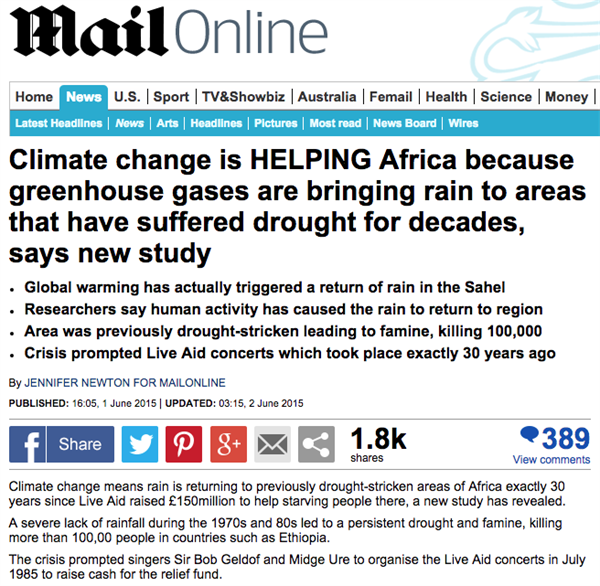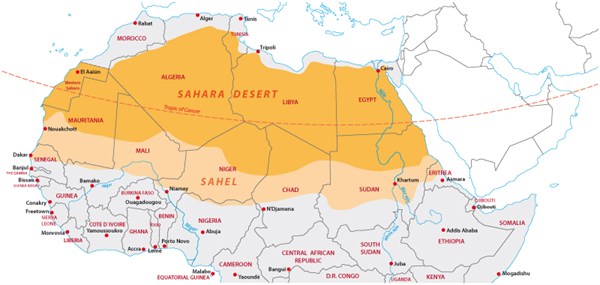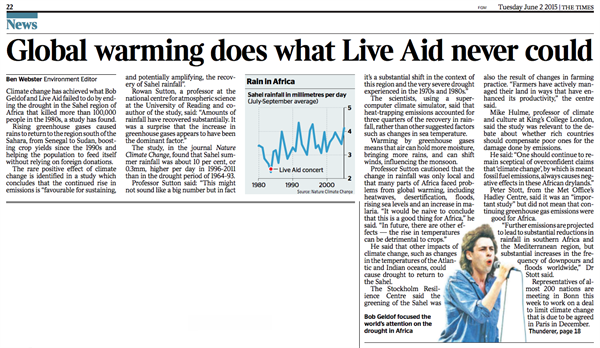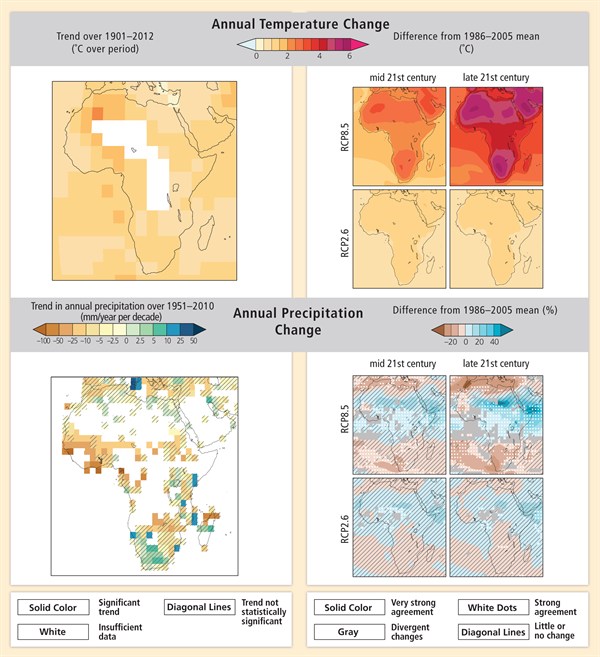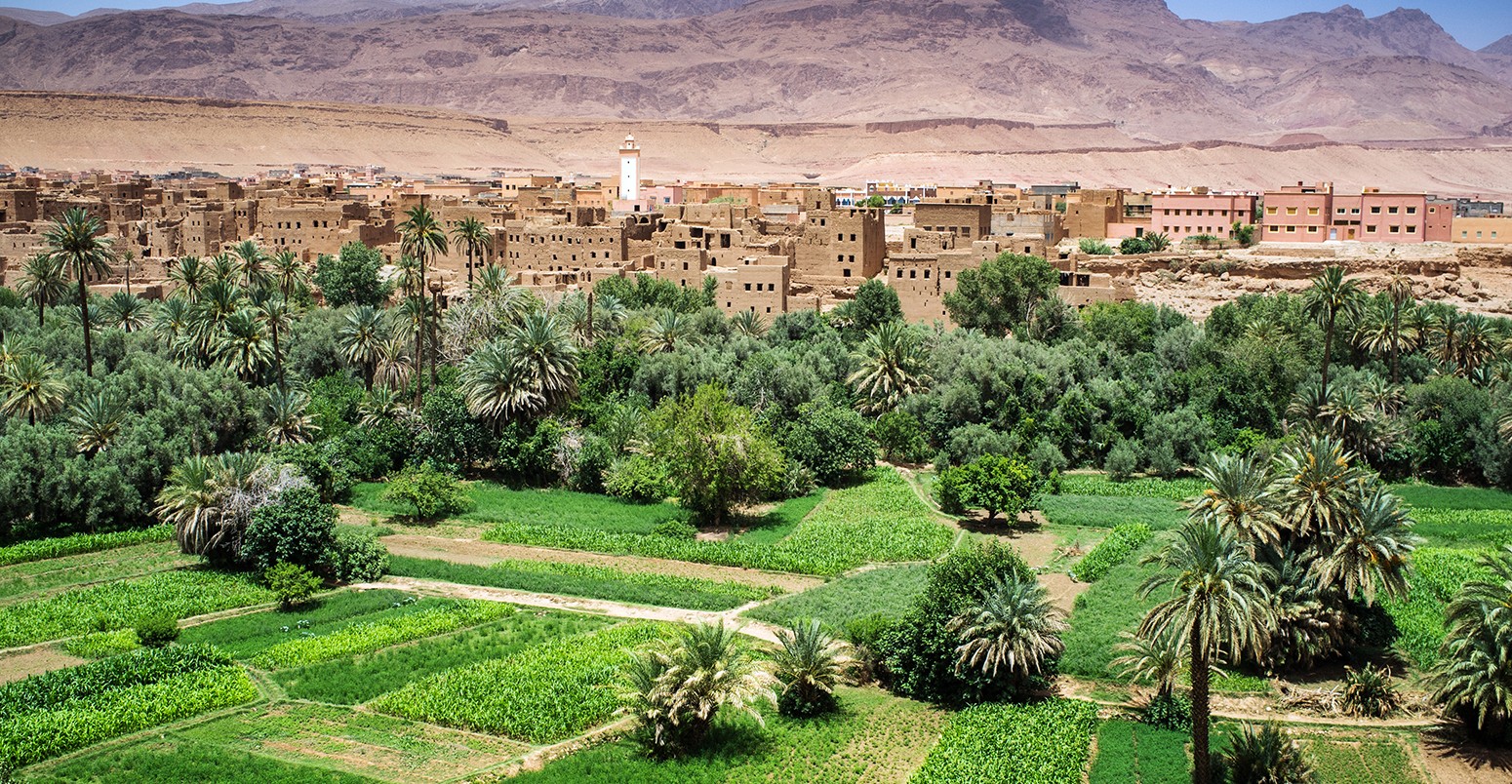
Factcheck: Is climate change ‘helping Africa’?
Carbon Brief Staff
06.03.15A new paper saying greenhouse gases in the atmosphere have boosted rainfall in a drought-stricken region of Africa has received quite a lot of media attention in recent days.
The study, published on Monday in Nature Climate Change, found that rainfall in the Sahel region of Africa has increased by 10% in the past few decades, and that it could be down to climate change.
Despite no mention in the study of easing famine, a press release from the University of Reading made the link between the “accidental” return of “life-giving rains” in the Sahel to Bob Geldof’s Live Aid concerts, held across the world in 1985 to raise funds for victims of famine.
A string of dramatic headlines followed. A comment piece by Geoffrey Lean In The Telegraph declared, ‘Global warming has fought famine’, while The Times declared, ‘Global warming does what Live Aid never could’. Reuters opted for the more muted, ‘Climate change boosts rain in Africa’s Sahel region’, while The Express suggested the new research means ‘African drought is OVER’. MailOnlinewent a step further, its headline suggesting ‘Climate change is HELPING Africa’.
The study’s author tells Carbon Brief claims that climate change is “helping Africa” are misleading and that a temporary respite from the Sahel drought is no reason to slow action on tackling climate change.
MailOnline. Monday 1 June 2015.A boost to rainfall
The Sahel region of Africa stretches from the Atlantic coast of Mauritania and Senegal through to Sudan, Eritrea and the Red Sea. Between the 1950s and 80s, rainfall dropped by around 40%, causing widespread drought and famine.
Map showing Sahara desert (dark orange) and the Sahel region just to the south (pale orange). Source: Shutterstock
But recent years have seen something of a recovery, according to the new research.
An average day’s rainfall during the summer rainy season is now around 0.3 mm higher than it was during the drought period. The study’s co-author Prof Rowan Sutton, director of climate research at the National Centre for Atmospheric Science (NCAS) at the University of Reading, tells Carbon Brief:
“[The increase] may not look that large, but the recovery had been about a 10% change in the seasonal average rainfall. This is a semi-arid region and those changes are significant.”
The graph below from the paper shows the change in average daily rainfall. The black bar is the period of drought and the red bar is where rainfall has increased since the mid-1990s. The recent increase is equivalent to around a third of the drop that caused the drought in the first place, the paper says.
Time series of annual June to September rainfall in the Sahel, in mm per day. The three different lines show the three different datasets used. Source: Dong & Sutton ( 2015)
A human driver
Past research suggests the drought in the 1970s and 80s was triggered, at least in part, by aerosols resulting from human activity. Now, the new study suggests humans might inadvertently be the cause of a partial recovery, Sutton tells Carbon Brief.
Rain only comes to the Sahel in the summer months, as the tropical rain belt moves north from the equator and then returns south again. This migration is caused by the sun, Sutton says:
“The sun heats up the land more rapidly than the ocean, and that temperature gradient – the higher temperatures over the land than the ocean – causes the rain band to move northward.”
His team’s model simulations show that human-caused climate change is making this temperature gradient stronger because the land is warming up more quickly than the oceans. Sutton explains:
“It turns out that greenhouse gases do something rather similar – they also cause greater warming over land than over the ocean. [This] amplifies the normal seasonal cycle, causing the rain band to move a bit further north and intensify a bit.”
The Times. Tuesday 2 June 2015, p.22
Bringing relief
So, just how far does this signal good news for the region?
It’s important not to draw too much from the new findings, says Sutton. For one thing, they only look at rainfall and conditions on the ground are more complicated in reality. He tells Carbon Brief:
“The notion of whether it’s ‘good’ or ‘bad’ is a very simplistic framing. It will have had some benefits, but we’re just looking at one variable.”
Since temperatures are rising globally, more moisture is being evaporated off the land. That’s important when thinking about drought, Sutton says:
“That is leading to a higher drought risk regardless of changes in rainfall. And that will be something that’s true across most of Africa. If you get more rain and it just evaporates really quickly then it’s not much good for the crops, for example.”
Prof Michela Biasutti, expert in tropical climate change at Columbia University and lead author of a lot of the research on the Sahel region cited in the latest IPCC report, tells Carbon Brief it’s been known for some time that global sea surface temperature and land temperature affect rainfall in the Sahel.
But not all models agree that greenhouse gas build up has led to more rain in the region. That depends on whether they include the response of the ocean on long timescales, she explains.
Using results about the past to try to predict future conditions is unwise, Biasutti says.
“There is absolutely no need to extrapolate from this model result about the 20th century and say something about the next decades.”
Model projections suggest drought conditions will prevail, Biasutti adds, though there is still some uncertainty about this. She says:
“[Model] projections are still uncertain but do prefer increased precipitation. They also indicate that the evaporative demand will go up to more than enough to compensate for rainfall changes, so that drought conditions are expected to continue.”
Crop yields are likely to suffer in the region even with even with increased rainfall, Biasutti adds:
“If one worries about future famine, one can directly go to the literature about crop yields under global warming. There is plenty to indicate that, even with increasing rain, reduced yield and volatility are still on the cards.”
African continent
Even if a recent return of the rains has offered respite to people in the Sahel, this doesn’t mean climate change is “helping Africa” as a whole, Sutton says:
“It’s very misleading to suggest that climate change is a good thing for Africa. There’s no doubt that the overall impacts of climate change on Africa are very serious. Potential short-lived benefits will be greatly outweighed by longer-term costs.”
The latest IPCC report suggests Africa will face increased risks from climate change, including increased risk of heatwaves, flooding and drought, crop failures, water shortages, and disease.
The impacts will vary widely from region to region across the continent, but some places will experience warming of between 3C and 6C by the end of the century under the highest emissions scenario (RCP8.5).
Annual average temperature change between 1901 to 2012 (top left) and precipitation change from 1951 to 2010 (bottom left). Projected annual average temperature change (top right) and precipitation (bottom right) for 2046-2065 and 2081-2100 under RCP2.6 and 8.5, relative to 1986-2005. Source: IPCC Working Group 2 contribution to the Fifth Assessment Report ( Chapter 22)
A brief respite
Sutton says more work is needed to see if his findings are reproduced in other models that might respond differently to greenhouse gases, but that we can still have confidence in the new results.
The bottom line, he says, is that a possible short-term positive impact on Sahel rainfall shouldn’t be a reason not to act on climate change.
“One of the reasons that the issue is so serious is that the impacts are essentially irreversible on timescales of centuries to millennia. So we don’t have the option of waiting to see whether the benefits might be a bit better than we fear.”
It’s not all about what could happen in future either. The new study is a reminder that climate change is already having consequences, says Sutton:
“Our new study shows that our activities are not just causing problems for future generations. They are causing major changes now â?¦ I trust the governments meeting later this year in Paris will appreciate the gravity of this message.”


